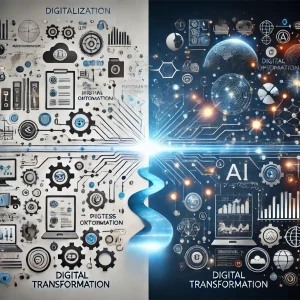
Are you evolving with the digital age, or simply surviving it?
Too often, organisations confuse digitalization with digital transformation using them interchangeably, assuming that adopting the latest tech is the final goal. But these terms are not the same, and understanding their differences could mean the difference between thriving in your industry, or being left behind.
So, let’s get clear on what they mean, why they matter, and how to decide where to focus.
What is Digitalization?
Digitalization is about modernising the way you work. It’s the transition from manual or analogue processes to digital ones. Think of it as replacing outdated methods with streamlined, efficient systems.
Examples of Digitalization:
- Converting paper files into digital formats
- Automating repetitive tasks like invoicing or payroll
- Migrating on-premise tools to the cloud
It’s an essential step to improve productivity and reduce errors. But while digitalization enhances what you already do, it doesn’t challenge or reimagine how you operate.
What is Digital Transformation?
Digital transformation is a mindset shift, it’s about rethinking your entire business model through the lens of technology. This isn’t just about improving processes; it’s about creating new ways of delivering value and staying competitive.
Examples of Digital Transformation:
- A bank using AI to deliver personalised customer services
- A hospital system implementing telemedicine to extend care access
- A retailer leveraging data analytics to predict consumer trends and drive decisions
Digital transformation touches every part of your organisation, culture, strategy, leadership, and operations. It’s about reinvention, not just improvement.
Key Differences at a Glance
| Aspect | Digitalization | Digital Transformation | |
|---|---|---|---|
| Focus | Automation and efficiency | Innovation and value creation | |
| Scope | Individual processes | Entire business strategy | |
| Goal | Improve what exists | Reimagine what’s possible | |
| Cultural Impact | Minimal | Organisation-wide shift | |
Which Should You Focus On?
Your focus depends on where you are and where you want to go. Here’s how to decide:
1. Understand Your Current Position
- Are your processes still heavily manual or outdated? Start with digitalization.
- Do you already have modern systems but struggle with innovation or competitiveness? It’s time for digital transformation.
2. Define Your Goals
- If your primary goal is efficiency or cost reduction, digitalization can deliver immediate benefits.
- If you are aiming for growth, market leadership, or customer-centric innovation, digital transformation is essential.
3. Evaluate Your Readiness
Digital transformation requires bold leadership and a workforce prepared to embrace change. Is your organisation ready for that journey?
Why the Difference Matters
Many organisations stop at digitalization, thinking they’ve “gone digital.” But this is just the first step. Digitalization will help you run faster, but digital transformation is what allows you to run in the right direction.
The most innovative companies today didn’t just digitise, they transformed how they operate, engage customers, and compete.
A Roadmap to Success
Whether you’re focusing on digitalization, transformation, or both, success requires a deliberate approach.
- Start with a Clear Vision. Where do you want your organisation to be in 5–10 years?
- Align Leadership and Culture. Transformation starts at the top, but it must permeate the organisation.
- Focus on Customer Value. Every decision should ask: how does this make life better for our customers?
- Embrace Change. Transformation is uncomfortable, but staying the same is far riskier.
The Bottom Line
Digitalization is the foundation; digital transformation is the evolution.
By understanding where you are and where you want to be, you can chart a path that ensures not just survival, but success in the digital age. The key is to act decisively and focus on what truly matters, delivering value and staying ahead.
